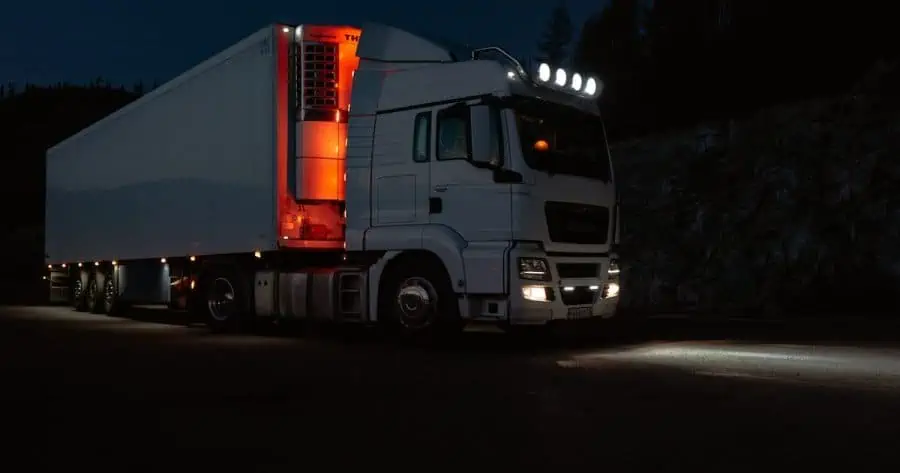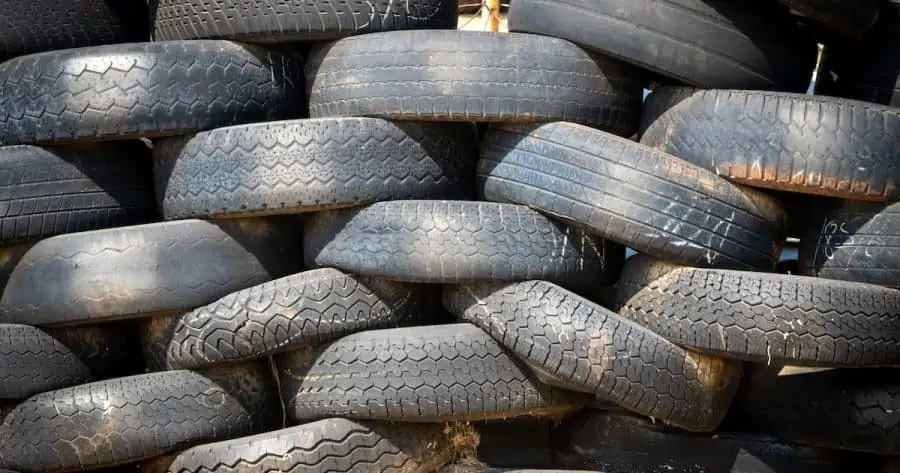
Tires that are worn out can put both the driver and passengers of the car in danger. They lack the required amount of tread that would enable the air to travel between their grooves. They are, therefore, a prime location for heat accumulation and consequent blowouts.
There are several causes of internal tire wear. Long-term wheel misalignment, an incorrect camber angle, worn-down ball bearings, and joints, or a damaged suspension part are all possibilities.
Before we get into the causes of internal tire wear, let’s look at different tire wear types and what they tell us about only one tire wearing on the inside.

Contents
What Causes Only One Trailer Tire Wearing Inside?
Although you may not be a tire specialist, clues in tire wear types like inner and outerwear, center wear, edge wear, cupping, and patchy wear can allow you to comprehend the internal workings of your vehicle and why only one of the tires is wearing on the inside.
Learn what to look for when checking some tire wear patterns as we walk you through what you can do to help address them.
Inner or Outer Shoulder Wear Due to Misalignment
If you look at your tires and notice that the inner or outer edge is wearing down faster than the rest of the tread, your car’s wheels are probably not in the right place. Your wheels may be tilting excessively to one side, which is often the result of misalignment, according to this wear pattern.
Don’t wait for alignment repairs; alignment issues can compromise steering, suspension, and perhaps your protection.
Center Wear Due to Over-Inflation
You could be traveling on tires that are often over-inflated if the center of your tires are losing tread quickly. The middle of the tread will wear down considerably more quickly than the remainder of the tire when your tires are inflated over the permissible pressure because they will ride along it.
Check your tire pressure frequently and refer to your owner’s handbook for the vehicle’s optimum tire pressure!
Edge Shoulder Wear Due to Under-Inflation
Edge wear, as opposed to center wear, can happen when tires are under-inflated. The part of the tire that makes the greatest contact with the pavement when you’re driving on under-inflated tires will wear down faster.
Reiterating the importance of doing so, make a habit of frequently checking your tire pressure after obtaining the required tire pressure for your motorhome from your owner’s handbook. Wear on two shoulders may also indicate incorrect rotation or harsh corners.

Cupping Due to Suspension Issues
Your car’s suspension system may be to blame if you see sporadic smooth areas on your tires or tiny dips in the tread wear. Particularly, suspension components are likely to be worn down or even twisted out of shape.
Maybe you just struck a curb or a pothole. When you’re driving, if you hear a faint rumble or see a cup pattern, you should get your suspension inspected, and any worn or misaligned parts changed.
Diagonal Patchy Wear Indicating Need for Rotation
Patchy tire wear may indicate a balancing issue. It’s time to have your tires rotated and maybe aligned if you look at your tires and see that the wear is uneven. You can avoid this unequal wear from getting worse over time and boost the longevity of your tires by rotating them regularly.
Here’s a helpful video on diagnosing your tires’ wear problems:
Why Are Your Tires Internally Wearing Down?
There are a variety of possible causes of inner tire wear, assuming you’ve previously seen any symptoms. There are a couple of those that are extremely prevalent. We’ll talk about them right now:
Camber Angle
The wheels’ vertical alignment and the road’s camber angle differ from each other. The tire should be able to rest level on the road at the correct camber angle. If your wheels are not in line, that might not occur, so in that scenario, the camber angle can be “positive” or “negative.”
The top of the tire is forced to stick out wider than its bottom by a positive camber angle. Its outer border deteriorates as a result of this. On the other hand, a negative camber angle compels the tire’s top to curve inside and its bottom to protrude out wider than its top. Inner tire wear occurs from this.
Toe Settings
Your tire is always under the influence of two forces. The first ones are those who consistently pull the tire inside. And then there are some that consistently nudge it outside. Toe settings have the dual purposes of balancing these forces and ensuring that the tire is pointing straight.
Your tire may tip inward or outward if the toe settings are out of line. The forces tugging on the inside of the tire are dominant if the tire is facing inward as a result of improper toe settings. Wear on the inner tire will quickly follow suit.
Worn-Out Ball Joint
Ball joints are crucial for maintaining the tires’ optimal rolling, even though they are invisible from the exterior. They accomplish the same thing by joining the tire’s lower and upper control arms with the wheel hubs on your car. They are not, however, damage-proof.
Ball joints begin to deteriorate after prolonged use. Their grip on the wheel is reduced as a result, and the tire’s inside is exposed. When your car passes speed bumps or potholes, your suspension making odd noises is one of the most typical signs of damaged ball joints.
Faulty Springs
Your car’s springs are in charge of ensuring that your trips go smoothly. Together with shock absorbers, they dampen the vibrations that your car experiences as it travels over potholes and other road imperfections. A ride without vibrations requires that they function at their best.
However, springs deteriorate over time, much like ball joints do. Their capacity to assist your car in maintaining continual contact with the road is diminished as a result. As a result of internal tire deterioration, tires take the brunt of this situation.

Worn-Out Tie Rods
Uneven and inner tire wear can also be attributed to worn tie rods. Premature wear will result from not frequently inspecting and greasing the tire rods. As is common knowledge, a tie rod is the link between the steering wheel and the car’s wheels.
If it malfunctions, the tires will wobble, and the steering wheel will shake, in addition to causing inner tire degradation.
Faulty Shock Absorbers or Struts
Will worn-out struts contribute to interior tire wear, you may be wondering. Clearly, worn shock absorbers or struts may also be to blame for the wear on the inner tire. The vehicle may bounce significantly if the shock absorber is broken or leaking, especially on an unpaved road. If this isn’t fixed right away, it might seriously harm other suspension system parts. The tires’ tread may develop an outside or inner pattern as a result.
When driving on uneven terrain, every time you accidentally drive over a pothole or hit a speed bump, it can also cause the steering wheel to tremble.
Worn Bushings on The Control Arm
The steering knuckles and the chassis are connected by control bushings, which also act as a linkage or connection. Elastomer or rubber fittings were used by automakers to construct a control arm’s two ends. These bushings are designed to stop or lessen the vehicle’s excessive play, which might have a negative impact on the camber angle.
As the control arms are used, they gradually age and start losing their bushings. The wear makes the wheel move too much, affecting how the camber angle is adjusted. Due to the excessive movement and camber angle concerns, the unfavorable impacts led to both outer and inner tire degradation.
Bad Wheel Alignment
Incorrect wheel alignment can cause a range of problems with the suspension parts, including issues with the wheel hub bearings, uneven tire wear, and inner and outer tire wear. What exactly is the root cause of poor wheel alignment?
A pothole impact may result in poor wheel alignment for your car. When you’re on a straight piece of pavement, it may force your car to pull in one direction.
Excessive Load
Trailer tires wear differently when underloaded versus overloaded. When there is insufficient weight on the axle to push the tire in a straight upward and downward motion, the tire stays “pigeon-toed” during the ride, which causes the tire wear to be concentrated on the outside of the tire.
Because the tires now face in the opposite direction from being underloaded whenever the axle is overloaded, this leads the tires to wear from the inside. The trailer load is excessively heavy if you notice that all four tires are wearing more quickly inside.
How Can Inner Tire Wear Be Fixed?
Fixing inner tire wear requires following these steps.
1. Align Your Wheels
Uncorrected wheel alignment can affect camber angle, degrade ball joints, and harm springs if neglected for a long time. As previously mentioned, each of these three disturbances increases the wear on the inner tire. For this reason, you ought to get your wheels aligned every 5,000 miles or a year.
2. Maintain Proper Tire Inflation
The danger of inner tire wear is increased with underinflated tires. That’s because their sidewall won’t be able to force the tire to make contact with the pavement anymore. Therefore, we advise that you periodically check the pressure of your tires.
If you cannot always find the time to drive to the tire shop, invest in a portable tire inflator.
3. Frequently Check Your Tire Balance
The majority of auto owners only balance their wheels when they see uneven tire wear. That strategy is incorrect. The ideal schedule for tire maintenance is once every two years.
Additionally, experts advise getting fresh tires adjusted right after mounting them on your car, as people wouldn’t need to worry about inner tire wear if they did so in the first place. Prevention is always better than the cure!
4. Replacing or Repairing Damaged Suspension Parts
Check the suspension system if you see uneven tire wear on one side of a vehicle wheel. A damaged suspension component might cause the inner tire to wear out more quickly. The vehicle’s peak speed can drop due to this issue.
The engine will try to make up for this by using more gas, increasing fuel consumption. You should be aware that ignoring suspension problems for a long time may result in an expensive repair and leave you stranded. If a faulty suspension part is the cause of excessive tire wear, it is straightforward to repair or replace it.

5. Check The Load Capacity of The Tire
Whenever the load exceeds the tire’s load capability, uneven tire wear on trailers can result. Regardless of whether the vehicle is not overloaded, this will nonetheless have the same impact on the tires.
For instance, each of the four tires on a tandem trailer with a 2000-pound gross load weight would need to support 500 pounds apiece. The load range that each tire can safely sustain is indicated by its “rated load range.”
Imagine you had a two-wheeled, 3000 lb. trailer with a tire capacity of just 1200 lb. If so, your real weight capacity is just 1200 lbs, and overloading the trailer to the axle’s weight limit rather than the tires’ can result in uneven tire wear.
Knowing the maximum load the trailer can support will help you pick trailer tires that can safely bear that load, plus a little more. Using Special Trailer (ST) tires, which are made to support the weight of various types of trailers, is also advised here. Like conventional vehicle tires, light truck tires feature unique constructions suited for hauling passengers.
Final Words
As soon as you have determined what is causing the inner tires to wear out, focus on a fix. Avoid ignoring the issue since it won’t go away. Such a negligent attitude will not only cost you dearly financially, but it will also jeopardize your vehicle’s and its occupants’ safety.